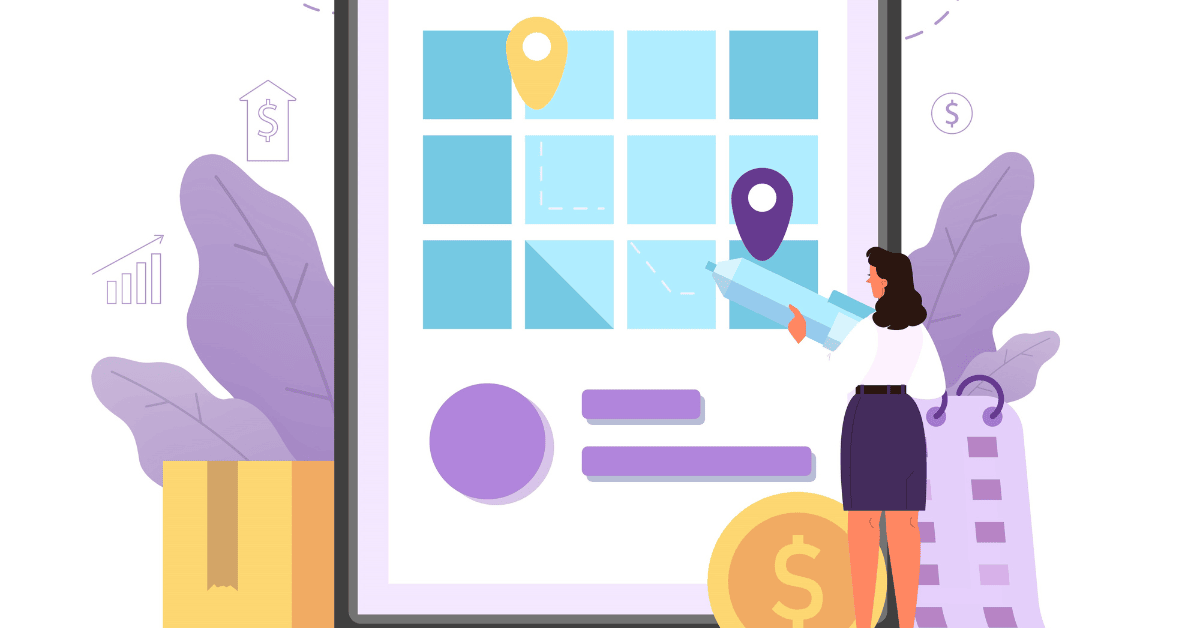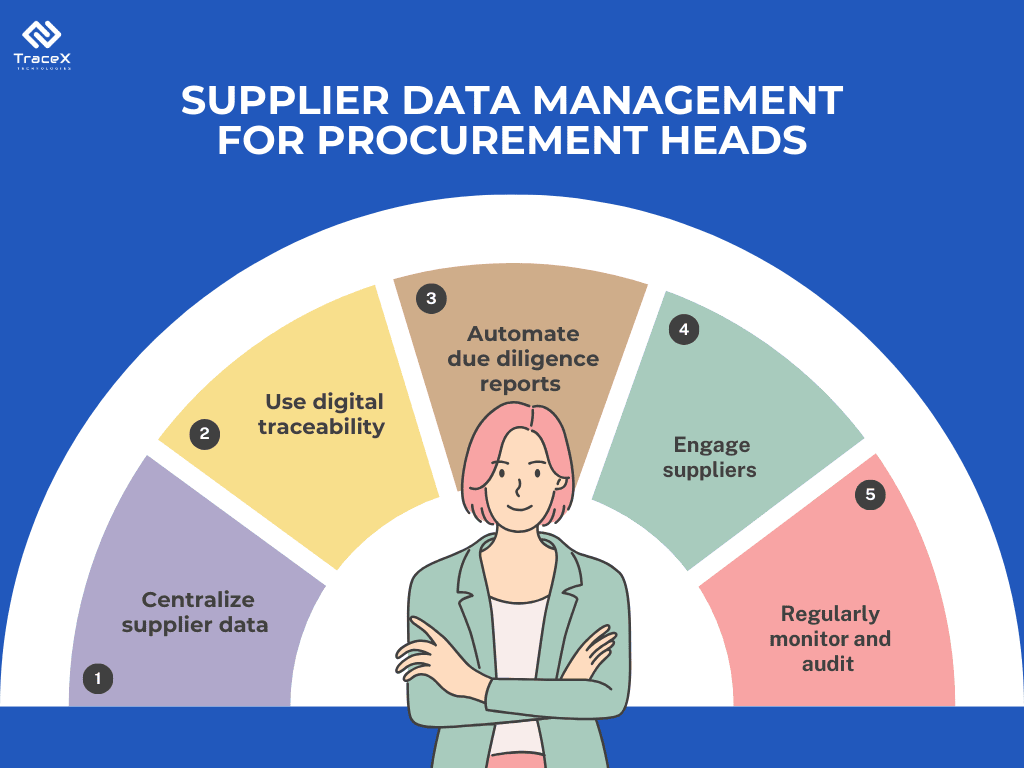Contact: +91 99725 24322 |
Menu
Menu
Quick summary: Learn how procurement heads can effectively manage supplier data for EU Deforestation Regulation (EUDR) compliance using advanced technology solutions. This guide explores key strategies to streamline data collection, verification, and reporting to ensure a deforestation-free supply chain.

As a procurement head in the food and agribusiness sector, managing supplier data management has always been a critical task. With the implementation of the EU Deforestation Regulation (EUDR), the complexity has only increased.
According to Deloitte’s findings, 82% of companies have integrated supplier risk evaluations into their data management practices, with the goal of recognizing and minimizing risks linked to suppliers.
The new regulation mandates that companies must ensure their products are deforestation-free, and this means meticulous tracking of supplier practices, land use, and supply chain transparency. For procurement heads, the challenge is clear: how to manage supplier data effectively to stay compliant while maintaining operational efficiency?
Key Takeaways
Supplier data management is at the heart of ensuring compliance with the EU Deforestation Regulation (EUDR), and it’s something many companies are navigating right now. To meet EUDR requirements, you need to demonstrate that your products are free from links to deforestation or forest degradation. That sounds straightforward, but it means collecting and managing a lot of information about your suppliers—especially if you’re sourcing from regions with a higher risk of deforestation. So, how do you effectively manage this supplier data?
First, you need to establish strong relationships with your suppliers. It’s not enough to just know their names; you need to gather detailed information about their sourcing practices. This includes where the raw materials are coming from, how the land is managed, and whether they have certifications for sustainable practices.
Next, you’ll need to gather key data points that will satisfy EUDR compliance. This involves more than just checking boxes—it’s about understanding the environmental impact of your supply chain. Think about data like geographic sourcing information, land-use history, and certifications that prove sustainable practices. The tricky part? This data often spans multiple tiers of suppliers, so it’s crucial to go beyond your direct suppliers and look at where they’re sourcing too.
Managing all this data manually is nearly impossible, especially if you have a complex supply chain. That’s where digital tools come in. Solutions like blockchain or supply chain management platforms can help you securely track and store supplier data. These tools allow you to monitor, verify, and trace every step of your product’s journey, ensuring the data is accurate and easily accessible for audits or compliance reporting.
Compliance isn’t a one-time thing. To stay on top of EUDR requirements, you need to continuously monitor your suppliers. This means setting up regular check-ins, updating data as supply chains evolve, and staying informed about any changes in regulations or risk factors. A system that automates alerts for non-compliance or potential red flags can help you stay proactive.
Finally, all this data isn’t just for show—it’s what you’ll need when the EU asks for proof of compliance. Having a well-organized supplier data management system will make it much easier to provide the documentation required during audits. With everything in place, you’ll be able to prove that your supply chain meets the EUDR’s deforestation-free standards, ensuring your business avoids fines and stays competitive in the market.
The EUDR places a strong emphasis on due diligence, requiring businesses to prove that their products do not contribute to deforestation. This means gathering detailed information about your suppliers’ land-use practices, environmental policies, and sourcing methods—especially when working with commodities like palm oil, soy, coffee, and wood.
However, food and agribusiness supply chains are notoriously complex. Suppliers operate across different regions, often in remote areas with limited technological infrastructure. Data collection becomes fragmented, with inconsistent formats and reporting standards. As a result, procurement heads are left juggling multiple data sources, all while trying to ensure compliance and avoid fines or product rejections in the EU market.
Problem
One of the biggest hurdles in managing supplier data for EUDR compliance is the lack of centralized systems. Many companies still rely on manual processes, spreadsheets, and disparate systems that make it nearly impossible to maintain accurate and up-to-date records. A centralized data management platform is essential for streamlining this process.
Solution
Benefit
A centralized platform not only ensures that all supplier data is in one place, but it also allows for more efficient reporting and auditing, which are key for EUDR compliance.
Problem
The foundation of EUDR compliance is traceability—the ability to track a product from its origin through each step of the supply chain. To achieve this, procurement heads must digitize their processes and make use of technology solutions that offer end-to-end traceability.
Solution
Benefit
By integrating these technologies, procurement heads can ensure complete visibility into their supply chain, enabling them to easily demonstrate compliance with EUDR regulations.
Problem
Manual reporting processes are not only time-consuming but also prone to errors, which can lead to non-compliance and penalties under the EUDR. To meet due diligence requirements, companies must regularly report on their suppliers’ deforestation risks, sourcing methods, and environmental impact. Automating these reports will save time and reduce human error.
Solution
Benefits
Automation simplifies compliance, providing procurement heads with clear, actionable reports that meet regulatory demands without the hassle of manual data input.
Problem
For procurement heads to successfully manage supplier data for EUDR compliance, they must also engage with their suppliers. Many suppliers may not have the systems or knowledge in place to meet EUDR requirements. As a procurement leader, building stronger relationships and collaborating on sustainability goals will go a long way in ensuring compliance.
Solution
Benefits
Strong relationships with suppliers can help ensure that they are motivated and equipped to meet EUDR standards, reducing your overall compliance risks.
Problem
EUDR compliance is not a one-and-done task. Regular monitoring and auditing of your suppliers are crucial to maintaining compliance over time. Procurement heads should implement continuous monitoring systems to identify any potential risks as soon as they arise.
Solution
Benefits
By staying proactive with monitoring and audits, procurement heads can avoid compliance issues and demonstrate their commitment to sustainable sourcing.

One of the biggest challenges in EUDR compliance is keeping track of all your supplier data, especially when you’re dealing with multiple tiers of suppliers across different regions. Technology platforms designed for supplier data management can centralize this information in one system. You can store, track, and easily update crucial data such as geographic sourcing locations, land-use history, and certifications.
These systems also allow you to create a unified source of truth, giving procurement teams access to the same data in real-time. This centralized approach makes it easier to identify any gaps or risks in your supply chain and stay on top of your EUDR compliance requirements.
Collecting and verifying supplier data manually can be a time-consuming and error-prone process, especially when dealing with complex supply chains. Technology solutions can automate much of this process, reducing the administrative burden on procurement teams.
For example, blockchain technology can be used to create an immutable record of every step in the supply chain. This ensures the data is accurate and tamper-proof, making it easier to verify claims about deforestation-free sourcing. Digital platforms can also integrate with certification bodies and databases to automatically check if suppliers hold the required certifications.
Technology tools can help you stay proactive in managing risks. Risk mapping tools, powered by geospatial data and AI, can identify high-risk sourcing regions where deforestation or illegal land use is more likely. These tools can track deforestation hotspots and monitor changes in land use, giving you real-time insights into potential compliance risks.
Monitoring solutions also allow you to continuously assess your suppliers’ compliance status. For example, if a supplier begins sourcing from a new area, the system can alert your procurement team to review the new sourcing data and ensure it meets EUDR criteria.
To comply with EUDR, procurement heads need to provide clear, transparent documentation about product sourcing and land-use practices. Digital traceability solutions, such as blockchain, ensure that every piece of data is traceable back to its origin. With blockchain, each transaction or movement of goods along the supply chain is recorded and cannot be altered, creating a fully transparent system that is easily accessible for audits.
QR codes or digital labels on products can also be linked to this data, enabling real-time access for regulators or even end consumers, offering them insights into where and how the product was sourced. This transparency not only ensures compliance but also enhances your brand’s reputation for responsible sourcing.
Reporting is a critical part of EUDR compliance, and preparing for audits can be stressful without the right tools. Technology platforms can streamline the reporting process by automatically generating the necessary documentation from the supplier data you’ve collected.
Whether it’s producing detailed reports on sourcing regions or supplying evidence of sustainable practices, these platforms can pull together all the relevant data in a format that meets regulatory requirements. This significantly reduces the workload for procurement teams and ensures that you are always prepared for compliance audits with up-to-date, accurate information.
Another advantage of technology solutions is their ability to integrate with your existing enterprise resource planning (ERP) and supply chain management systems. This ensures that supplier data, purchasing records, and compliance information are automatically synced, reducing the risk of discrepancies and allowing for smoother management across the organization.
With seamless integration, procurement heads can easily pull the data they need without manually sifting through multiple systems, saving time and ensuring consistent, reliable data management.
The TraceX EUDR Compliance Platform is designed to help businesses meet the stringent requirements of the EU Deforestation Regulation (EUDR). By leveraging blockchain technology, the platform ensures end-to-end traceability across supply chains, providing tamper-proof records of sourcing practices and land use. It helps companies gather, verify, and manage supplier data efficiently, ensuring that products are sourced sustainably and free from deforestation links.
With features like automated risk mapping, real-time monitoring, and seamless integration with existing systems, the TraceX platform simplifies the compliance process, reduces the risk of non-compliance, and prepares businesses for audits. It also enhances supply chain transparency, positioning companies as leaders in responsible and sustainable sourcing.
For procurement heads in the food and agribusiness sector, managing supplier data for EUDR compliance is undoubtedly a challenge. However, by leveraging technology, centralizing data, automating due diligence, and building strong supplier relationships, this challenge can turn into a competitive advantage. Companies that can demonstrate deforestation-free, sustainable sourcing will not only meet regulatory requirements but also gain consumer trust and market leadership.
Supplier data management is crucial for EUDR compliance because it helps companies verify that their products are sourced from regions free of deforestation. Proper data management ensures that accurate information is collected and documented to meet regulatory requirements and avoid penalties.
Technology solutions like blockchain and digital traceability platforms automate data collection, provide real-time monitoring, and ensure secure, transparent records. These tools streamline compliance by reducing manual work, improving accuracy, and making supplier data readily available for audits.
For EUDR compliance, procurement heads need data such as the geographic sourcing of products, land-use history, sustainability certifications, and supplier risk assessments. This data proves that products are not linked to deforestation or forest degradation.
